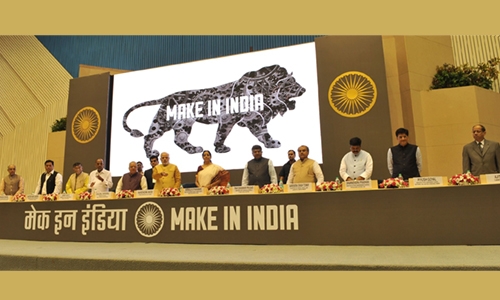An emerging economic giant
The Republic of India is considered one of the emerging superpowers of the world. This potential is attributed to several indicators, the primary ones being its demographic trends and a rapidly expanding economy. In 2015 India became the world’s fastest growing economy with an 7.5 per cent estimated GDP rate (mid year terms). Due to its high birth rate India has a young population compared to more developed nations.
It has approximately 65 per cent of its population below the age of 35. In addition, declining fertility is beginning to reduce the youth dependency rate which may produce a demographic dividend. In the coming decades, while some of the powerful nations will witness a decrease in workforce numbers, India is expected to have an increase. For example, while Europe is well past its demographic window, the United States entered its own in 1970 (lasting until 2015), China entered its own in 1990 (and will last until 2025), India entered its own in 2010 (and it will last until 2050).
In the words of Indian Scholar Rejaul Karim Laskar, “when greying population will be seen inhibiting economic growth of major countries, India will be brimming with youthful energy”. Regionally, South Asia is supposed to maintain the youngest demographic profile after Africa and the Middle East, with the window extending up to the 2070s. The economy of India is currently the world’s third largest in terms of real GDP (PPP) after the United States of America and the People’s Republic of China.
According to the World Bank India overtook China to become the fastest-growing major economy in the world as of 2015. Its record growth was in the third quarter of 2003, when it grew higher than any other emerging economy at 10.4pc. Estimates by the IMF show that in 2011, India became the third largest economy in the world, overtaking the Japanese economy and the Fifth largest economy by GDP (nominal). India is trying to develop more highly skilled, English speaking people to fit in the future knowledge economy.
India is becoming one of the world’s leading producers of computer software and with mushrooming R and D centres it is experiencing a steady revolution in science and technology. The Modi government was re-elected in a landslide victory in May. Prime Minister Narendra Modi’s first term was punctuated with many reforms including the introduction of GST, bankruptcy and insolvency changes, digitisation of subsidies that resulted in large numbers of Indians now having bank accounts, and a steep rise in infrastructure spending on building roads, rail and electrification to power the nation.
India’s road and rail networks are critical to increasing its population’s standard of living and economic prosperity as they connect farmers to markets, children to education and goods to consumers. During Modi’s first term, India built almost 200,000 kilometres of rural roads. The number of rural villages connected by roads grew to 91 per cent, up from 56 per cent in 2014.
Modi’s new government has pledged 100 trillion rupees ($2.07 trillion) over the next five years for infrastructure investment. This is huge considering the expenditure on roads and railways was about only 1.2 trillion rupees for the 12 months to March 2019.
Related Posts

